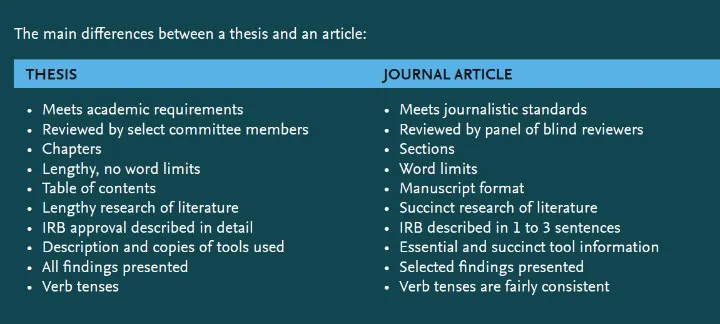Authors' Update - keeping journal authors in touch with industry developments, support and training

Infelizmente, não oferecemos suporte total ao seu navegador. Se for possível, atualize para uma versão mais recente ou use o Mozilla Firefox, o Microsoft Edge, o Google Chrome ou o Safari 14 ou mais recente. Se não conseguir e precisar de suporte, envie seu feedback.
Gostaríamos de receber seu feedback sobre essa nova experiência.Diga-nos sua opinião abre em uma nova guia/janela
22 de março de 2018 | 5 min lidos
Por Laura Mesquita

Sharing insights from the latest Researcher Academy webinar
Many first-time authors use the research conducted as part of their PhD or even Master’s thesis as a basis for a journal article. While that’s a logical step, the requirements for a thesis differ from those of a paper in a peer reviewed academic journal in very significant ways. Ensuring that you are familiar with these can prove the difference between acceptance and rejection…
Elsevier’s Researcher Academy abre em uma nova guia/janela recently hosted a live webinar abre em uma nova guia/janela on turning your PhD thesis into an article. In this webinar, Dr. Adolfo Cuevas, Assistant Professor at Tufts University, Dr. Cecily Betz, Editor-in-Chief of the Journal of Pediatric Nursing, and Dawn Nahlen, Publisher at Elsevier, discussed eight golden tips to help you transform your thesis into a research paper for publication in a journal.
Some of the differences between articles and theses are rather clear – consider word limits and the level of detail you should employ in your study. Others, however, are much less obvious. For instance, verbs in a thesis may be in the future “I will research” and in the past tense “I researched”. In journal articles, authors tend to describe a study that has already taken place and so tenses are much more consistent.
Some other key differences are listed below.

Make sure to read the aims and scope of journals you are interested in to be as certain as you can be that your paper falls within the journal’s scope. If your research falls outside of the aims and scope, look for a more suitable home for your paper – as submitting it there would be a wasted effort. Check each journal’s recommended structure and reference style for articles on its website, typically found in the “guide for authors”, to ensure that your paper is not desk rejected. You might find it useful to look at Elsevier’s Journal Finder tool abre em uma nova guia/janela when trying to identify a fit for your article.
Journal articles are typically much shorter than theses (the precise word limit will normally be stated in the guide for authors), so be sure to use a tighter framework and a more compact style. This will mean:
Treating your thesis as a separate, new work
Paraphrasing where needed to express the same idea in different ways
Selecting parts of your thesis to repurpose (not all of it) and focusing on the main points you want the reader to understand
Writing an abstract abre em uma nova guia/janela can be difficult. Lucky for you, you already have a pretty good place to start. While abstracts in journal articles are usually much shorter (100-250 words) than the average thesis introduction, the two have one thing in common: both should contain all the key elements to command the reader’s attention and encourage them to read further. Using your introduction and part of your discussion as a basis for your abstract can be a good starting point.
Your thesis may have more than one research question or hypothesis, which are not all relevant for your paper. Consider combining your research questions or focusing on a single one for the article. Unless otherwise suggested, try to keep the introduction short and to the point. It can also be very helpful to use previously published papers (at least three) from the target journal as examples – try to fit in with the usual “form” for articles in the journal.
Often, there is no need for an overly descriptive methods section. While concerns surrounding reproducibility are becoming increasingly important, you may want to keep your methods section succinct and certainly remember your audience: your peers probably do not need every detail of tried and tested methods. A longer description of methods may be a requirement from your institute or funding body, and it is definitely warranted when innovative methods are deployed, but again: it’s a good idea to use papers previously published in the target journal as examples.
Be sure to present all the findings that are relevant to your research question(s) in the results section, before the discussion. If you conducted an exploratory analysis, be sure to provide at least a few concise statements on the findings.
A good starting point for a discussion section is an interpretation of your results: What is it that the reader will have learned from your research? Do not repeat your results in the discussion section, instead do the following:
Situate your findings in the literature
Discuss how your findings expand the perspective of the field
Briefly present ways in which future studies can build upon your work, and address limitations in your study
Unlike your thesis, where you can cite those foundational yet potentially dated sources and anything else you may have learned from, journals do sometimes limit the number of citations. For this reason, it’s important to make sure:
To choose the most relevant (and recent) citations
That the citations are formatted correctly
Pro tip: consider using a reference manager system (e.g. Mendeley abre em uma nova guia/janela) to make your life easier. When you’re picking the most relevant citations or quickly reformatting them, you’ll be thankful you did.
The tips presented here are just a short preview of a truly enlightening 60 minutes with an Elsevier publisher, a thesis supervisor and author, and a journal’s Editor-in-Chief. Be sure to catch the full webinar recording abre em uma nova guia/janela, entirely free, at the Elsevier Researcher Academy abre em uma nova guia/janela.
Final tip of the day: following the event, in the Researcher Academy Mendeley group abre em uma nova guia/janela, the webinar panelists answered the participants’ most burning questions from the Q&A – be sure to check it out!

LM
